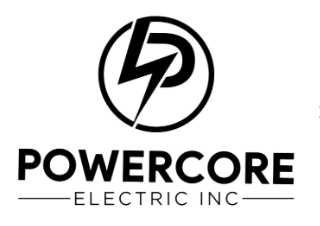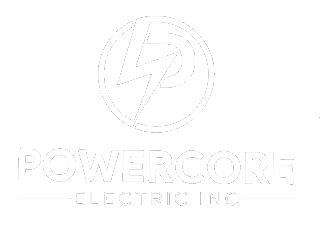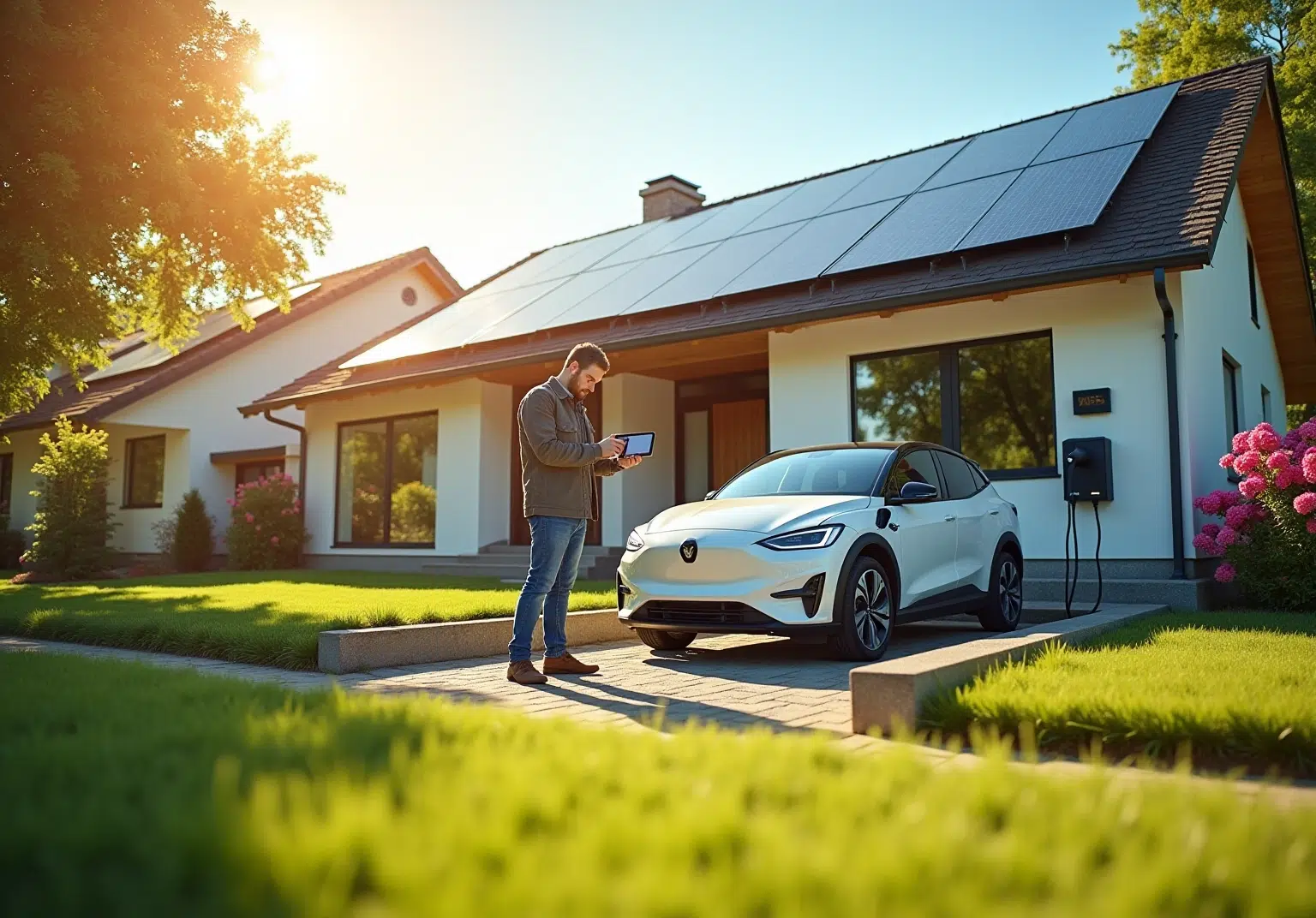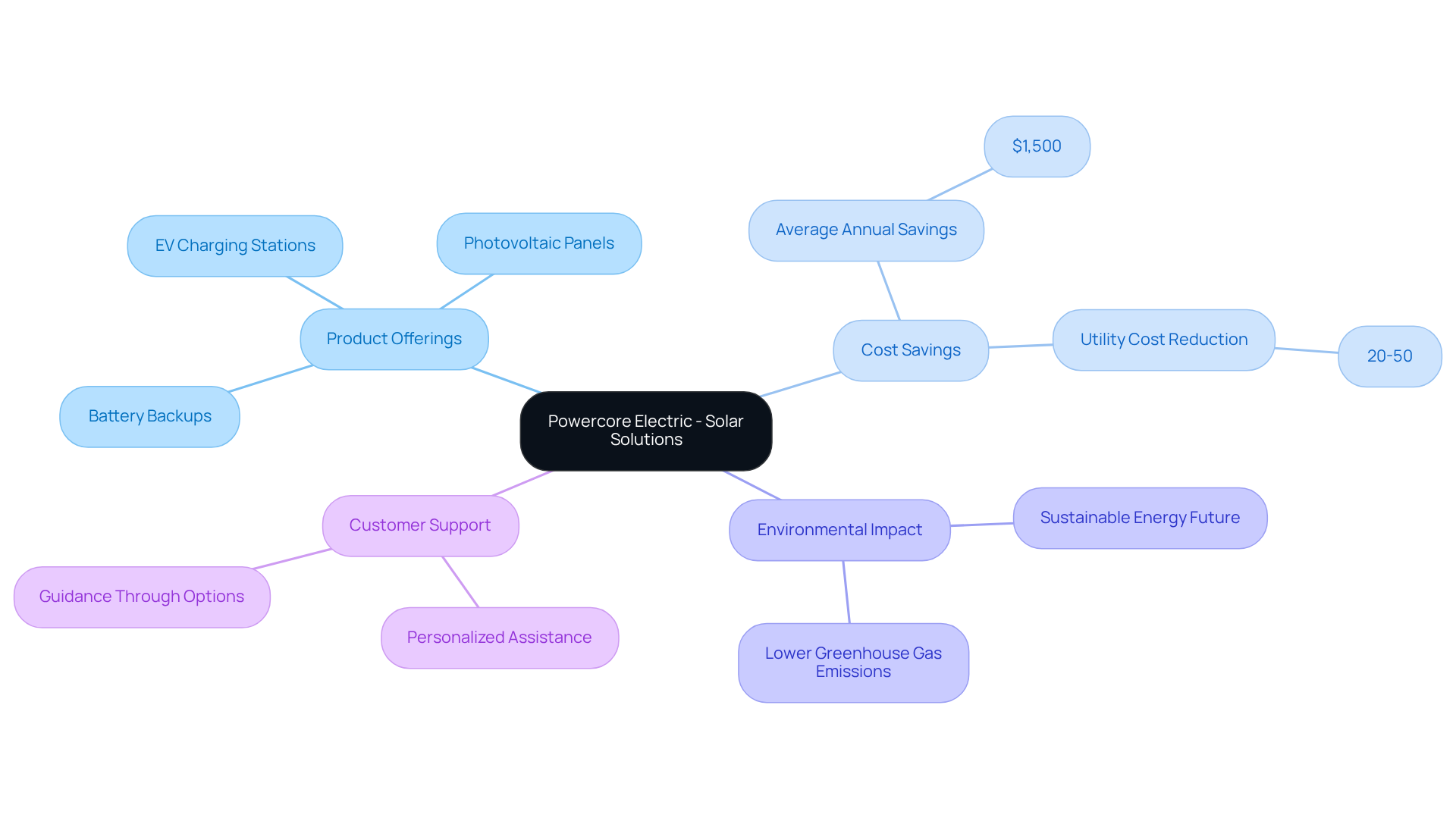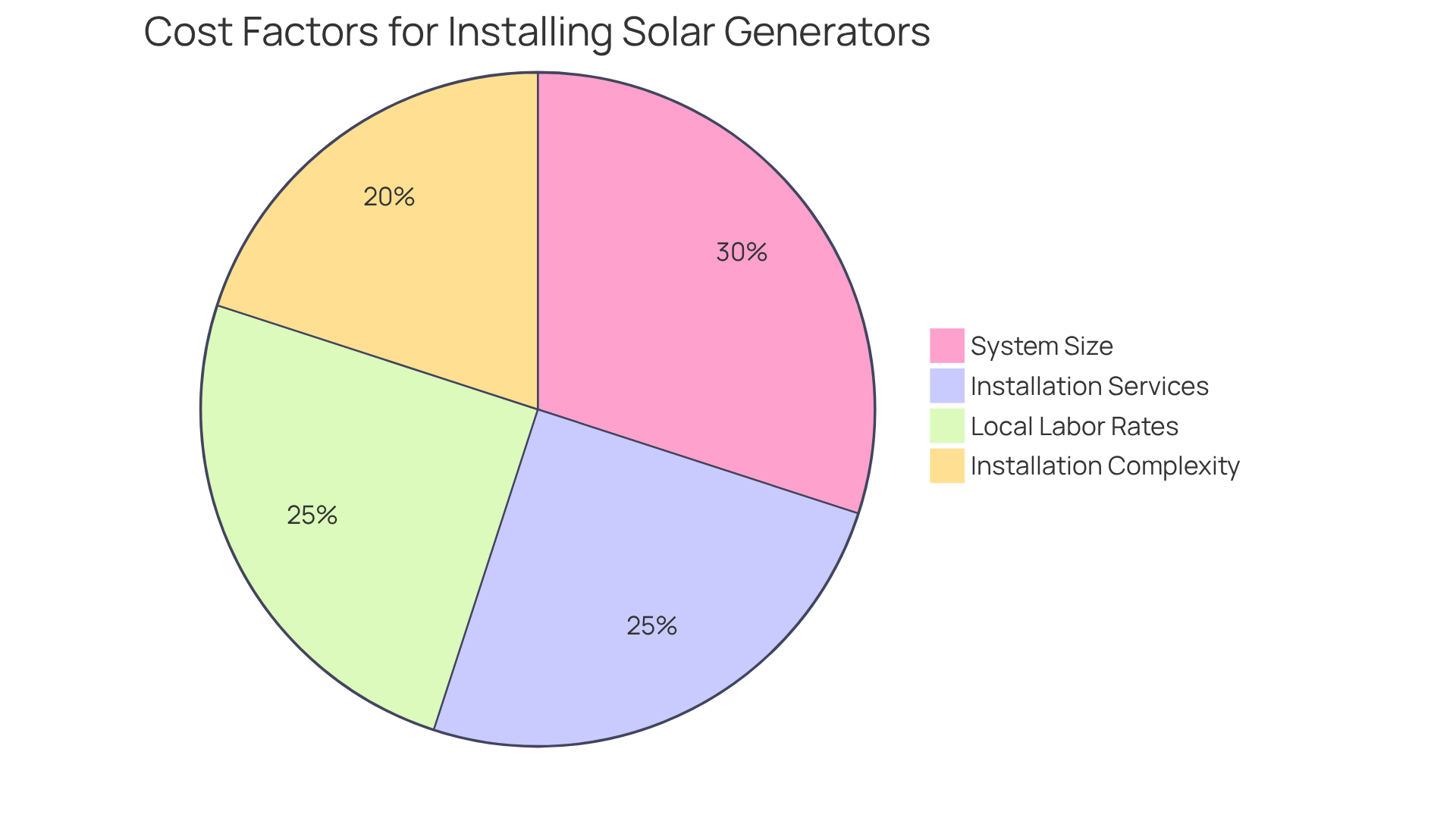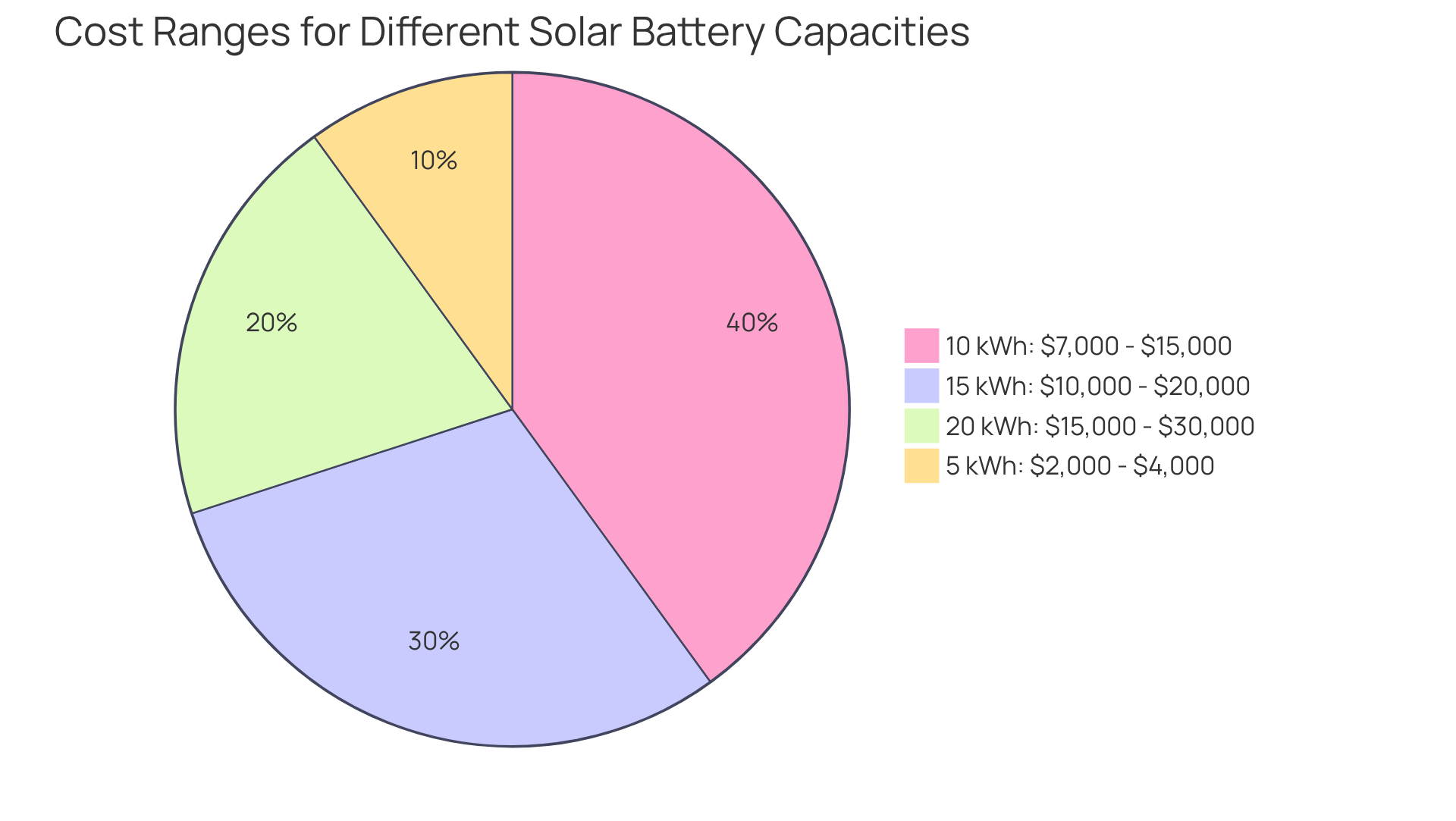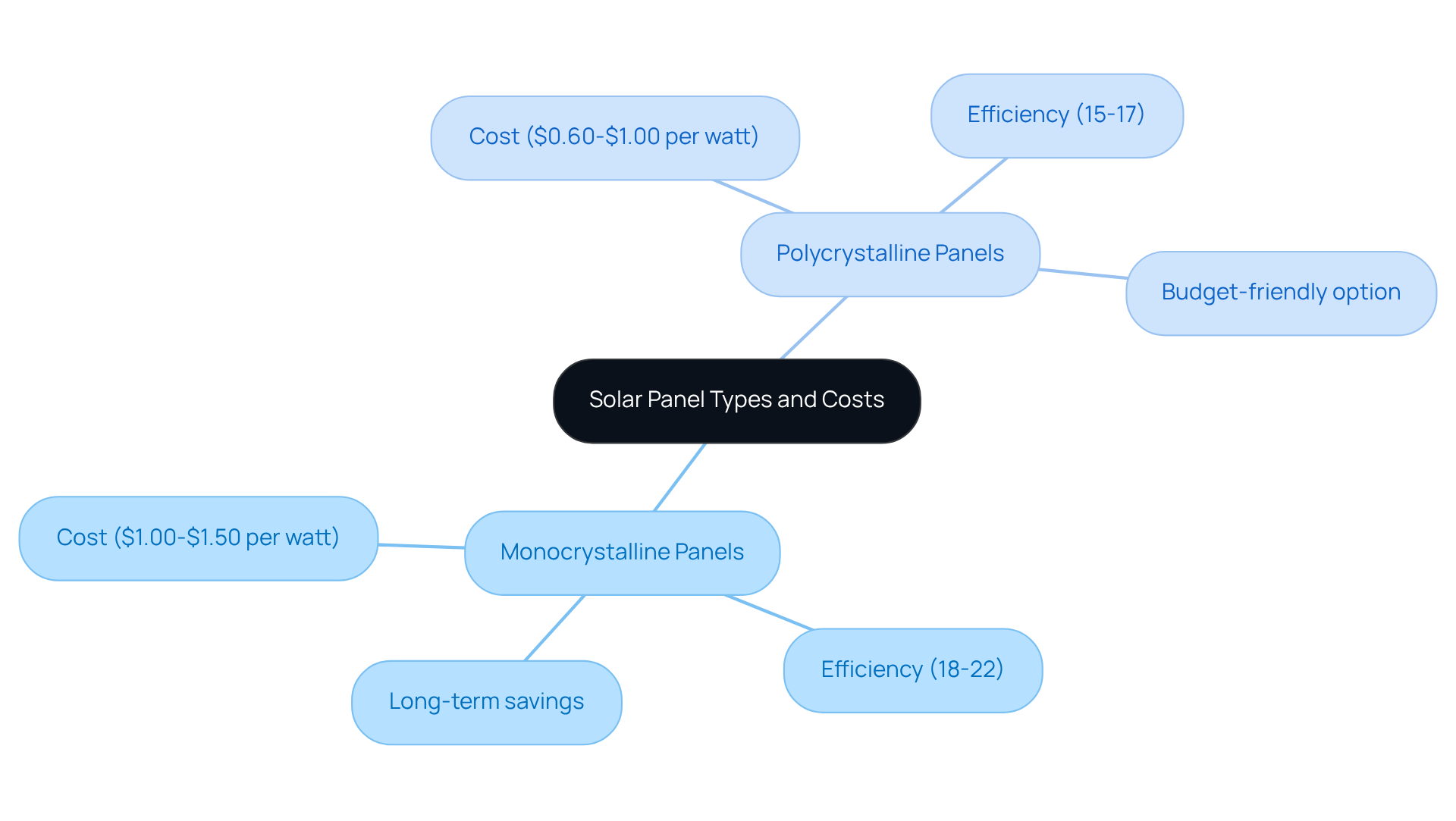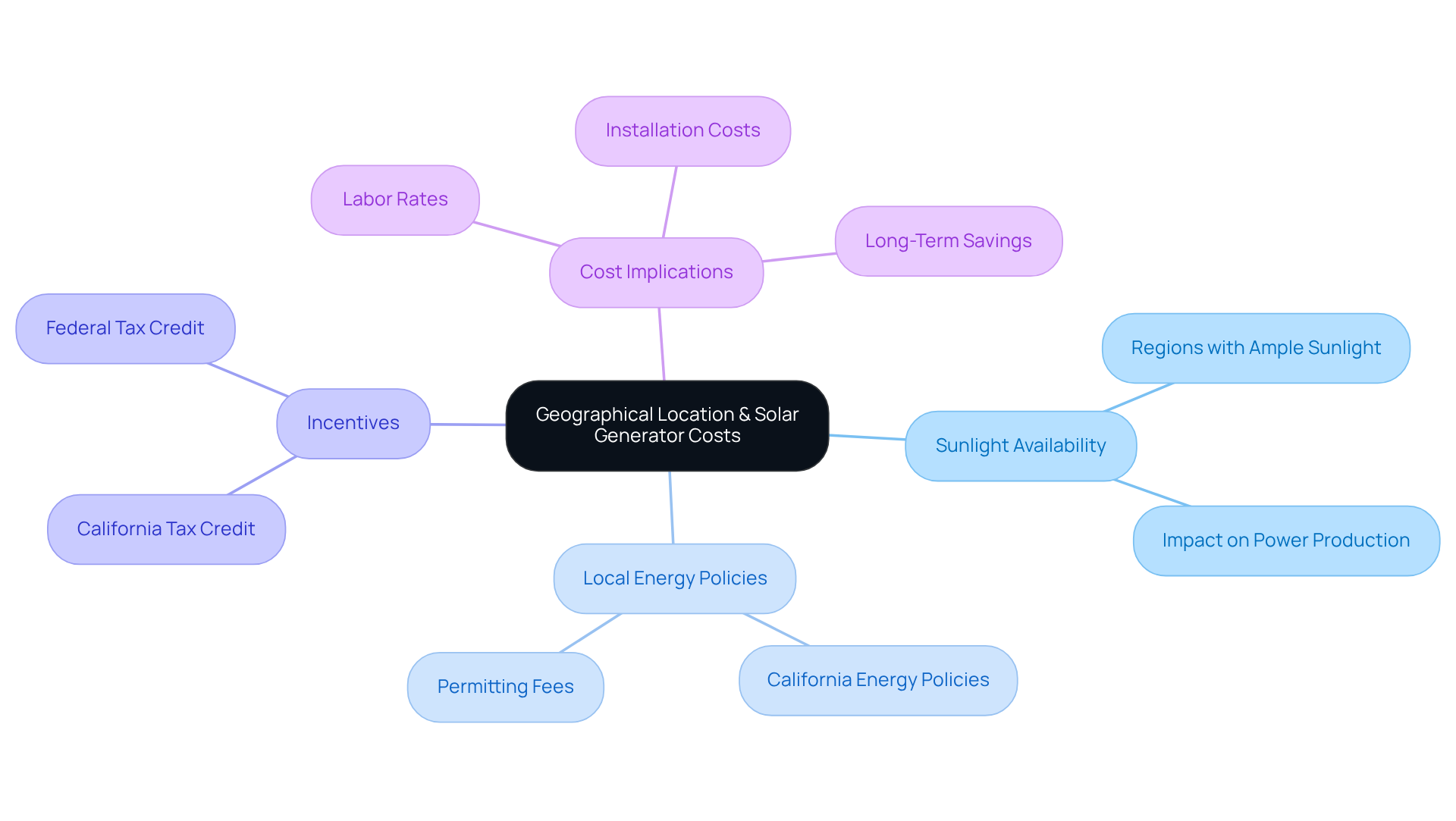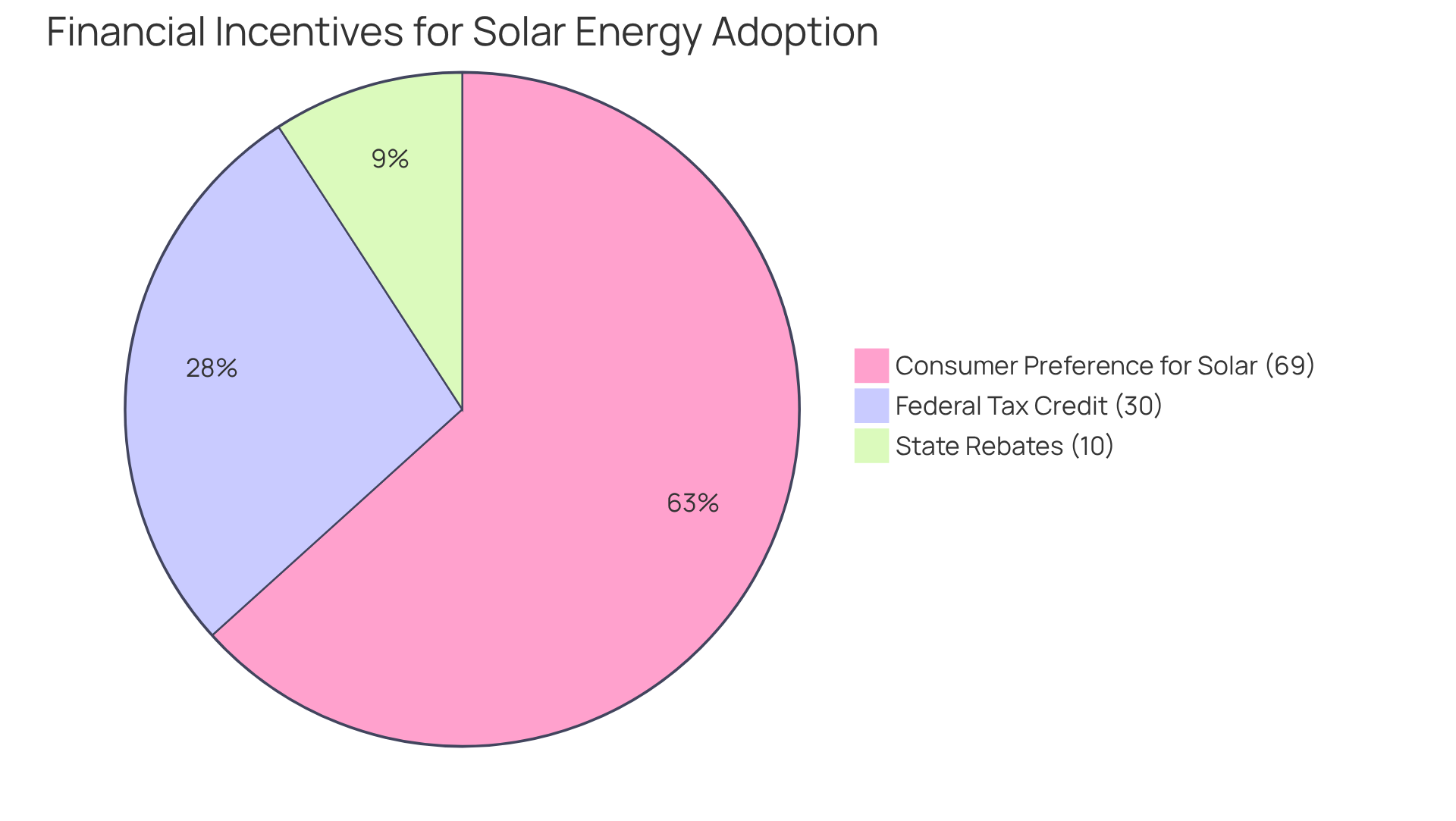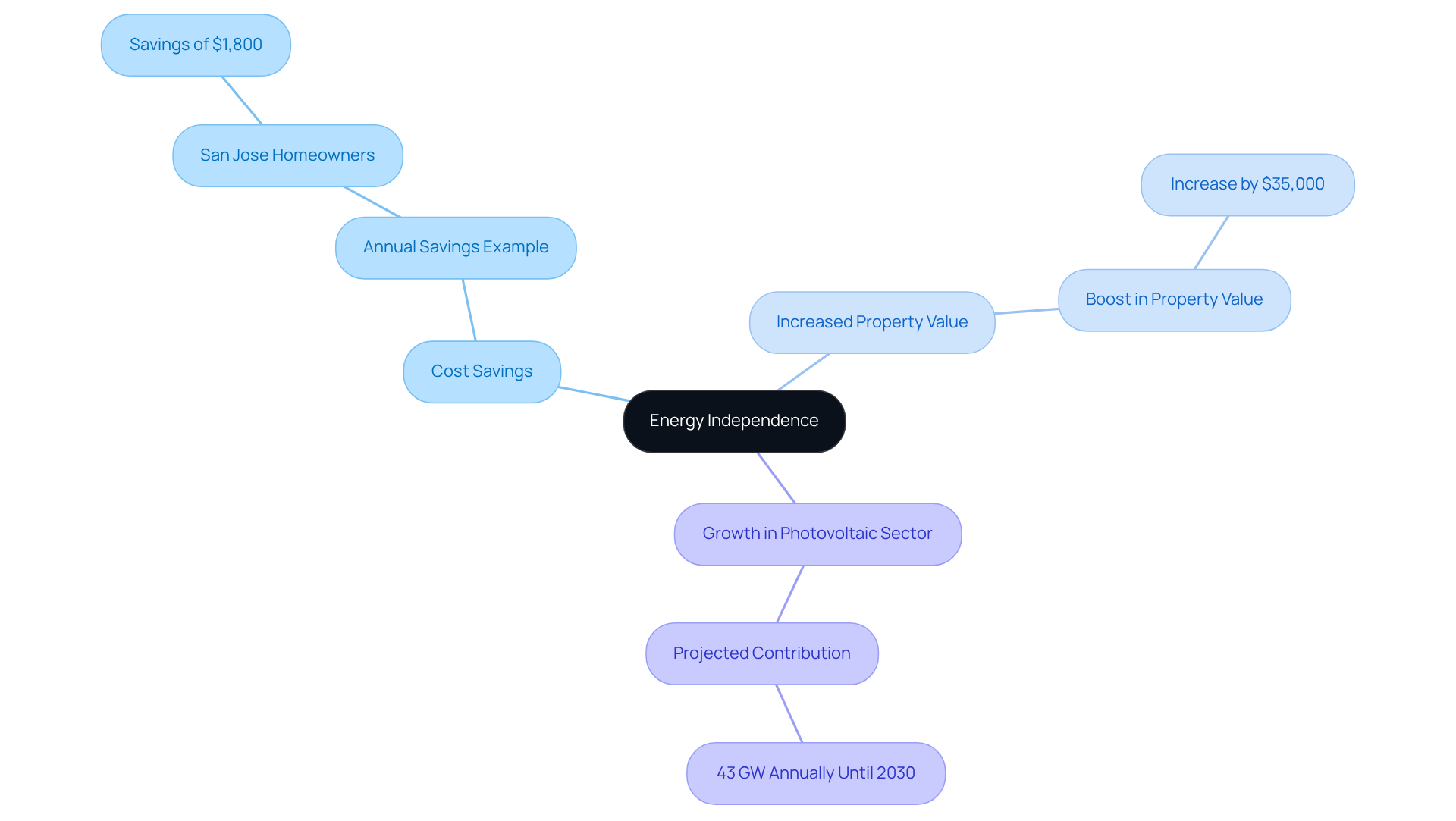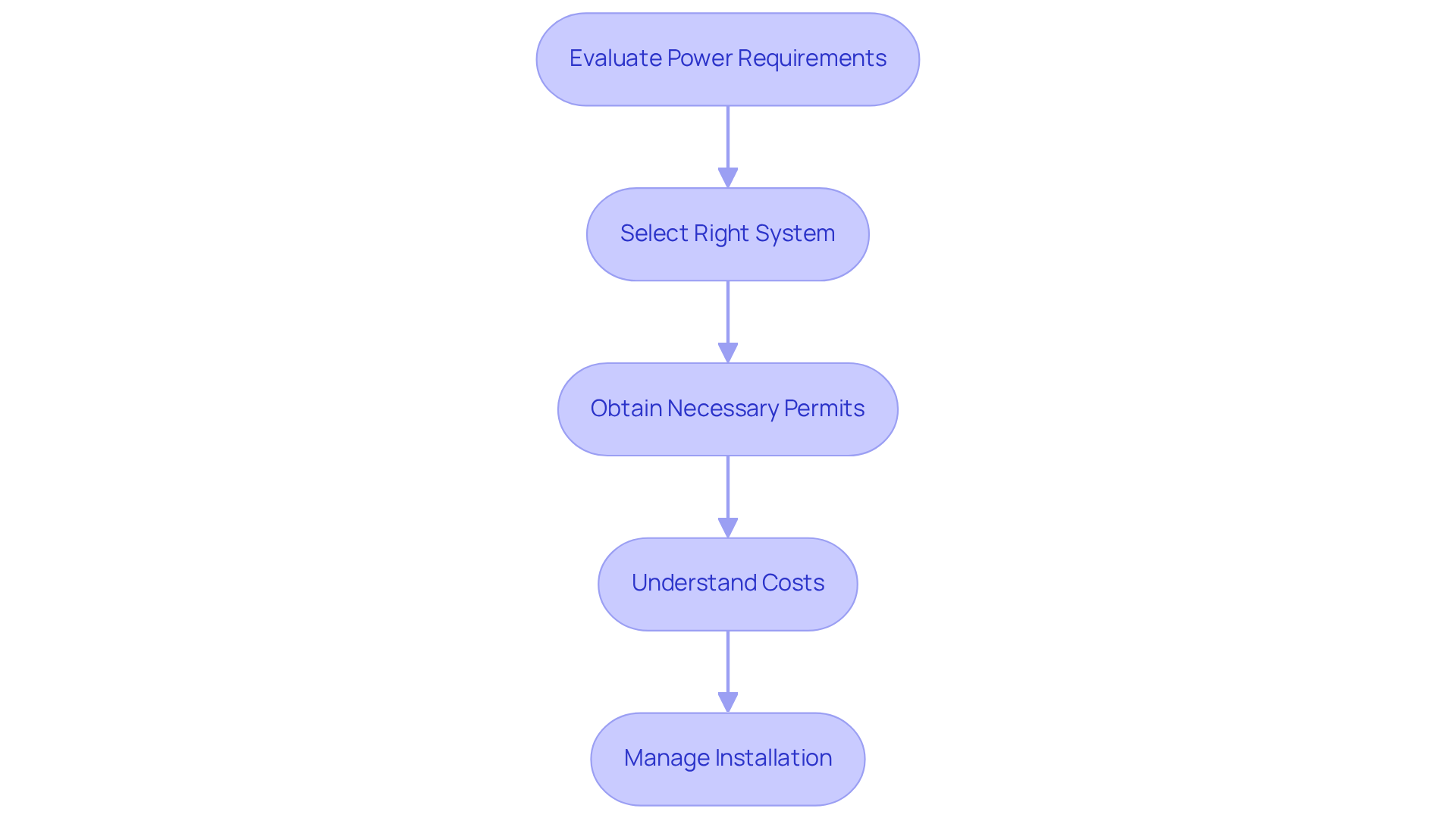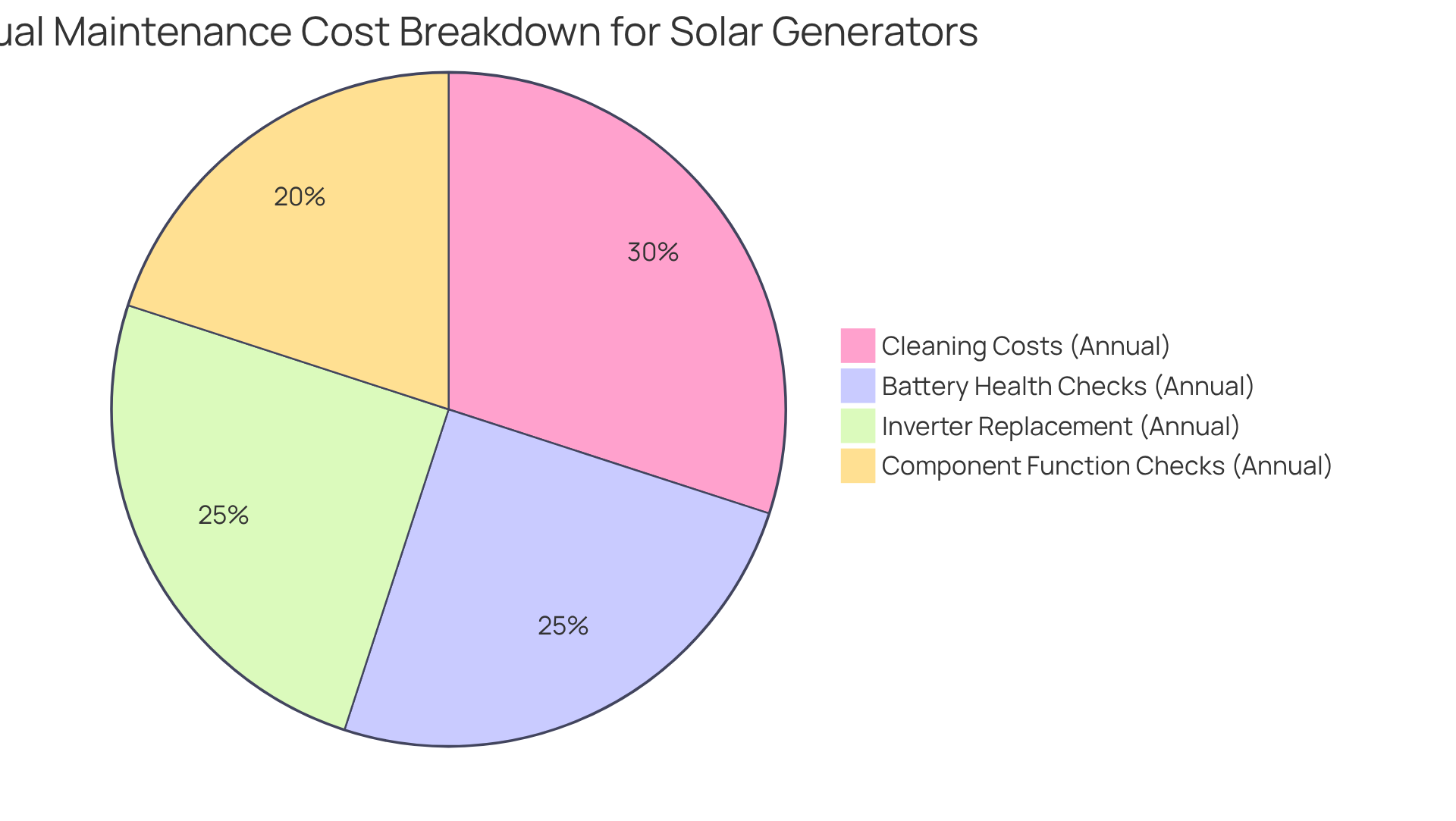Overview
We understand that many homeowners are concerned about rising energy bills and the impact they have on your budget. This article delves into the key factors that influence the cost of solar generators for homes, such as:
- Installation complexity
- Battery storage capacity
- Solar panel types
- Geographical location
- Government incentives
- Maintenance expenses
By examining each of these aspects in detail, we aim to provide you with valuable insights into how they affect overall pricing and potential long-term savings.
As you consider investing in solar energy solutions, it’s essential to recognize the benefits that come with it. Not only can solar energy help you reduce your monthly bills, but it also offers a path toward energy independence, allowing you to take control of your energy future. Together, we can explore how these factors play a crucial role in your decision-making process.
By understanding the nuances of solar energy costs, you can make informed choices that align with your values and financial goals. We hope this guide serves as a supportive resource, empowering you to take the next steps toward a more sustainable and cost-effective energy solution. If you have any questions or need assistance, please don’t hesitate to reach out—we’re here to help you navigate this journey.
Introduction
Understanding the intricacies of solar generator costs can feel overwhelming for homeowners eager to embrace renewable energy. It’s common to worry about the various factors involved—from installation expenses to battery capacity and geographical influences. Navigating this landscape is vital for making informed decisions that can lead to significant long-term savings.
In this article, we explore seven key elements that greatly impact the pricing of solar generators for homes, offering insights that can empower you to take control of your energy future.
What challenges might arise as you balance initial investments with future benefits? Together, let’s discover how you can strategically approach these decisions to ensure a sustainable and cost-effective energy solution that meets your needs.
Powercore Electric: Expert Solar Generator Solutions for Homeowners
For over 30 years, Powercore Electric has stood by homeowners like you, becoming a trusted leader in renewable energy solutions. We understand that can be a significant concern, and we are committed to providing quality solutions that ensure your satisfaction. Our skilled team is here to offer personalized assistance, helping you choose the perfect energy generator tailored to your unique needs.
Imagine harnessing the power of the sun, even on overcast days, with our high-efficiency photovoltaic panels. Alongside reliable battery backups and convenient EV charging stations, we provide a comprehensive selection of products designed to empower you. By embracing solar energy, you can potentially save an average of $1,500 each year, reducing your utility costs by 20-50%. It’s common to feel overwhelmed by the options available, but rest assured, we are here to guide you every step of the way.
Moreover, investing in renewable energy solutions not only brings financial relief but also contributes to a healthier planet by lowering greenhouse gas emissions. Together, we can make a difference. As the renewable energy market evolves, Powercore Electric remains at the forefront, ensuring you benefit from the latest advancements in technology and energy management. Let’s work towards a sustainable future together. Contact us today to explore how we can support your journey to energy independence.
Installation Costs: Understanding the Impact on Solar Generator Pricing
We understand that the expenses related to the can fluctuate considerably, which can be a source of concern for many homeowners. Factors such as system size, installation complexity, and local labor rates play a significant role in determining the costs associated with a solar generator for house cost. Typically, the solar generator for house cost includes installation expenses that range from $1,000 to $3,000 for professional services, but it’s essential to consider additional elements that may influence these figures. For instance, a complex roof design might require specialized mounting systems, leading to increased labor and material expenses. Moreover, local market conditions and competition among installers can cause price variations.
To ensure you receive the best value, we encourage you to obtain multiple quotes and carefully review what each estimate includes—this encompasses warranties and service agreements. Understanding these elements is crucial for making informed choices and avoiding unforeseen expenses during the installation process. Together, we can navigate these complexities and work towards achieving energy independence while minimizing your energy bills.
Battery Storage Capacity: A Critical Factor in Solar Generator Costs
We understand that can be a significant concern for homeowners. Battery storage capacity plays a crucial role in influencing the solar generator for house cost, with larger capacity batteries allowing you to store additional power. This capability is especially beneficial during peak demand times or outages, allowing you to make the most of renewable resources. For instance, the solar generator for house cost for a 10 kWh battery typically ranges from $7,000 to $15,000, depending on the specific technology employed.
As you assess your power consumption patterns, it’s essential to choose the ideal battery size that balances your initial investment with the potential long-term savings, especially when considering the solar generator for house cost. It’s common to feel overwhelmed by these choices, but understanding these dynamics is vital as the demand for energy autonomy increases. Together, we can navigate these options to find the best renewable power solutions for your home.
Imagine the peace of mind that comes with knowing you have control over your energy usage. By investing in the right battery storage, you’re not just making a purchase; you’re taking a step toward energy independence. If you have any questions or need guidance, we’re here to support you in making informed decisions for a sustainable future.
Solar Panel Type: How Technology Affects Generator Expenses
We understand that rising energy bills and the can be a significant concern for homeowners. The choice of solar panels for your generator system plays a crucial role in managing these expenses while enhancing efficiency. Monocrystalline panels, known for their exceptional efficiency and durability, do come at a higher price point, ranging from $1.00 to $1.50 per watt. On the other hand, polycrystalline panels offer a more budget-friendly option, typically costing between $0.60 and $1.00 per watt. When deciding on panel types, it’s essential to weigh your power requirements against the solar generator for house cost.
Investing in high-quality monocrystalline panels can lead to substantial long-term savings. Their efficiency, averaging between 18% and 22%, significantly outperforms the 15% to 17% efficiency of polycrystalline panels. This higher efficiency translates to reduced electricity expenses and a quicker return on investment, making monocrystalline panels particularly appealing for those with limited roof space and considerable power needs. Additionally, the thermal efficiency rating of these panels is crucial; it indicates how effectively they convert sunlight into usable energy, impacting your overall operational costs.
As highlighted by industry specialists, while the initial investment in monocrystalline panels may be greater, the long-term benefits often outweigh the solar generator for house cost. This is especially true for residents seeking energy autonomy and sustainability. Furthermore, heating systems can save homeowners between $400 to $600 annually on utility costs, promoting both independence and sustainable living. Together, we can explore these options to find the best solution for your energy needs, ensuring you feel supported every step of the way.
Geographical Location: Its Role in Solar Generator Cost Variability
Understanding the geographical position is crucial, as it significantly impacts the . Regions blessed with ample sunlight can produce more power, making investments in photovoltaics not only practical but also economically viable.
For tenants in Long Beach, it’s essential to grasp local energy policies and incentives; California offers beneficial programs, such as the federal tax credit for renewable energy, allowing property owners to claim 30% of their installed energy system expenses.
With California leading the nation in renewable energy production—approximately 52.5% of its electricity comes from sunlight—there’s a real opportunity for homeowners to embrace sustainable solutions. However, those in areas with less favorable sunlight conditions may face increased expenses due to local labor rates, permitting fees, and limited incentives.
We understand that navigating these complexities can be daunting. Case studies have shown that climate affects heater efficiency, underscoring the importance of investigating local conditions and regulations. By doing so, you can accurately evaluate the solar generator for house cost and enhance your investment potential.
Together, let’s explore how we can support your journey towards energy independence and sustainability.
Government Incentives: Reducing the Financial Burden of Solar Generators
We understand that managing energy bills can be a significant concern for homeowners. Government incentives, particularly the federal solar tax credit, offer a compassionate solution to ease the financial burden of purchasing a solar generator for house cost and EV charging solutions.
In 2025, property owners can benefit from a 30% tax credit on the total installation costs, which encompasses both equipment and labor. This means that for an average installation costing $20,000, you could receive a tax credit of $6,000, directly reducing your federal tax obligation.
Moreover, many states, including California, provide additional rebates and incentives that further lessen the overall expenses related to the solar generator for house cost. For instance, California property owners can take advantage of state-specific initiatives that complement the federal tax credit, enhancing the financial feasibility of renewable energy investments.
Financial analysts emphasize that these tax credits have significantly boosted installation rates, with over 69% of potential buyers expressing a preference for homes equipped with photovoltaic panels and EV chargers, including Tesla home chargers.
We encourage you to consult with local providers of renewable systems to explore the complete range of . Together, we can ensure you optimize your savings while transitioning to sustainable solutions.
Energy Independence: A Driving Force Behind Solar Generator Investments
We understand that rising energy bills can be a significant concern for homeowners. Energy independence acts as a strong incentive for those considering renewable generators. By generating their own electricity, homeowners can greatly reduce their dependence on the grid, effectively protecting themselves from the fluctuations of increasing utility expenses. This autonomy fosters peace of mind during outages and supports a sustainable lifestyle.
For instance, a recent case study revealed that a household in San Jose, after implementing a photovoltaic system under the 200% rule, lowered their utility expenses by $1,800 each year and boosted their property value by $35,000. As power costs continue to vary, the attractiveness of investing in photovoltaic generators increases, rendering them a more viable choice for individuals seeking greater control over their power sources.
It’s common to feel overwhelmed by the unpredictability of energy costs, but with the photovoltaic sector expected to contribute an average of 43 GW each year until 2030, the movement towards independence in power is likely to accelerate. This indicates a wider transition towards renewable power solutions. Together, we can embark on this . Reach out to us today for your complimentary customized estimate and begin your path towards power independence with Powercore Electric, your reliable partner for renewable solutions throughout California.
Long-Term Savings: Evaluating the Financial Benefits of Solar Generators
Are you concerned about rising energy bills? Investing in renewable energy generators, such as a solar generator for house cost, can provide significant long-term reductions in your energy expenses, with many property owners saving between $700 and $1,200 each year, depending on their energy usage and regional utility prices. Beyond these immediate savings, photovoltaic generators can greatly enhance your property value, making them a wise investment for the future. For instance, California residents can anticipate net savings of $75,000 or more over time, especially as electricity costs continue to rise, averaging a 2.8% yearly increase.
The payback period for photovoltaic systems typically spans from 5 to 8 years, allowing homeowners to recover their expenditure while enjoying years of decreased utility costs, which is important when considering solar generator for house cost. Additionally, properties equipped with renewable power systems often experience a rise in market value, as more buyers emphasize efficiency and sustainability. Financial consultants highlight that the return on investment for renewable power can be remarkable, with annual returns projected between 10% and 15%. This blend of savings and increased property value underscores the financial benefits of transitioning to renewable energy, particularly when considering the solar generator for house cost.
At Powercore Electric, we understand that making this shift can feel overwhelming. That’s why we leverage our local knowledge to provide customized solutions that not only meet the distinct power needs of California communities but also ensure unparalleled quality workmanship and a customer-first approach. Together, we can make your transition to sustainable power effortless and advantageous.
To discover how power generators can benefit you personally, reach out to us today for a tailored consultation. Let’s work together to reduce your costs while increasing your home’s worth. Your journey towards starts here.
Installation Process: Understanding Costs and Requirements for Solar Generators
Navigating the installation procedure for photovoltaic generators can feel overwhelming, but it’s a journey that leads to energy independence and savings. First and foremost, evaluating your power requirements is crucial. This means understanding how much electricity your household needs to thrive. It’s important to consider top battery options for efficient power storage, ensuring that your chosen system can effectively manage your power consumption patterns.
Next, selecting the right system tailored to your needs is essential. We encourage you to engage in conversations with your energy provider to explore options that resonate with your energy consumption habits. This includes understanding the functionality of photovoltaic panels and best practices for choosing energy inverters.
Obtaining the necessary permits is another vital step in this process. In California, specific regulations govern photovoltaic installations, including local building codes and interconnection requirements. Collaborating closely with your energy provider can help ensure that you adhere to these regulations, which can vary by municipality. This partnership simplifies the permitting procedure, often seen as a hurdle to adopting renewable energy.
As you organize the installation, keep in mind that the solar generator for house cost can vary based on system size, complexity, and the specific components you choose. For instance, the average solar generator for house cost in the U.S. is around $19,537, with installation costs being a significant factor. Proper planning and open communication with your installation team can lead to a smoother experience, minimizing delays and unexpected expenses.
Effective project management in renewable energy installations relies on clear timelines and defined roles among all parties involved. We understand that you may want to be actively involved throughout the process, ensuring that your expectations align with the capabilities of your chosen energy provider. By comprehending these essential steps and requirements—including the importance of regular panel maintenance for efficiency and longevity—you can more effectively manage the installation of energy generators. Together, we can work towards improved and savings, making your home a beacon of sustainability.
Maintenance Costs: Planning for Ongoing Expenses with Solar Generators
As a homeowner, you may have concerns about the solar generator for house cost and the ongoing expenses that come with it. While these systems require minimal upkeep, it’s important to anticipate a . Regular tasks such as:
- Cleaning solar panels
- Checking battery health
- Ensuring all components function properly
are essential. On average, maintenance expenses can range from $150 to $500 each year, depending on the size of your system and environmental factors. For instance, smaller systems around 3kW may incur costs under $200, while larger systems of 10kW or more could exceed $500.
Experts recommend setting aside approximately $100 each year for inverter replacements, as these components typically require replacement every 10 to 15 years. Additionally, [routine inspections and cleaning](https://nextenergy.ai/solar-panel-maintenance-cost-per-year) are crucial for maintaining optimal performance. Even slight declines in performance can accumulate over time, leading to greater issues down the line. Cleaning costs usually average between $5 and $25 per panel; for example, cleaning a 20-panel 3kW system may cost between $500 and $750. As one expert pointed out, ‘Did you observe a significant decline in power production?’ This concern can arise from various factors, with dust and debris buildup being the most common culprits. However, malfunctioning components can also contribute to these issues.
By proactively planning for these expenses and considering environmental factors that may influence performance, you can ensure that your solar generator for house cost operates efficiently. Together, we can work towards a more sustainable and environmentally friendly home, providing reliable energy for years to come.
Conclusion
Investing in a solar generator for your home is not just a financial decision; it’s a transformative step towards achieving energy independence and securing long-term savings. We understand that many homeowners are concerned about rising energy bills, and by exploring the various factors that influence the overall cost—such as installation expenses, battery storage capacity, solar panel types, geographical location, and available government incentives—you can make informed choices that align with your energy needs and budget. Each of these elements plays a crucial role in determining your investment, while also significantly contributing to long-term savings and environmental benefits.
Throughout this article, we’ve discussed key insights, including:
- The importance of evaluating installation costs
- Selecting the right battery size
- Understanding how different solar panel technologies can impact overall expenses
Additionally, we’ve highlighted the potential for government incentives to alleviate financial burdens, showcasing how these programs can enhance the feasibility of transitioning to renewable energy. The journey towards energy independence not only empowers you to reduce reliance on traditional utility sources but also fosters a sustainable lifestyle that benefits our planet.
As the demand for renewable energy solutions continues to grow, it’s essential to thoroughly explore your options. Embracing solar energy leads to significant cost savings over time, enhances property value, and contributes to a healthier environment. Taking that first step towards investing in a solar generator can pave the way for a more sustainable future, encouraging others to join in this vital movement. Together, we can create a brighter tomorrow. For those ready to embark on this journey, consulting with experts like Powercore Electric can provide tailored solutions that meet your specific energy needs, ensuring a smooth transition to renewable energy.
